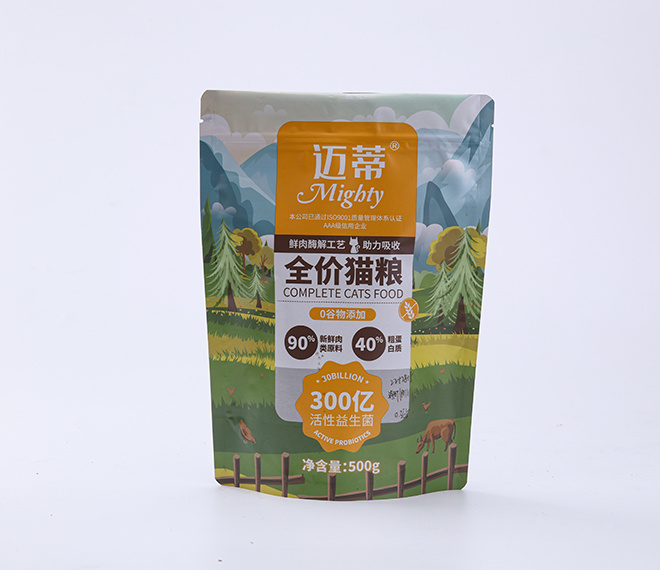How to Choose the Best Packaging for Your Cat Food: A Comprehensive Guide
2025-07-10
How to Choose the Best Packaging for Your Cat Food: A Comprehensive Guide
Table of Contents
Introduction to Cat Food Packaging
The Importance of Choosing the Right Packaging
Types of Cat Food Packaging Materials
Plastic Packaging
Paper Packaging
Metal Packaging
Composite Packaging
Understanding the Environmenta
How to Choose the Best Packaging for Your Cat Food: A Comprehensive Guide
Table of Contents
- Introduction to Cat Food Packaging
- The Importance of Choosing the Right Packaging
- Types of Cat Food Packaging Materials
- Understanding the Environmental Impact
- Consumer Preferences in Cat Food Packaging
- Sustainable Packaging Options
- Regulatory Considerations in Cat Food Packaging
- How to Choose the Best Packaging for Your Cat Food
- Conclusion
- FAQs about Cat Food Packaging
Introduction to Cat Food Packaging
The packaging of cat food plays a critical role in maintaining the quality and safety of the product. Not only does it protect the contents from external contaminants, but it also influences consumer decisions. The right packaging can enhance shelf life, provide crucial information, and even reflect brand values. In this guide, we will delve into the best practices for choosing cat food packaging tailored to meet the needs of both pets and their owners.
The Importance of Choosing the Right Packaging
Selecting the right packaging for cat food is essential for several reasons:
1. **Preservation of Freshness**: Proper packaging keeps the food fresh, preventing spoilage and retaining nutritional value.
2. **Safety**: High-quality packaging protects against contamination and potential hazards.
3. **Brand Image**: Effective packaging communicates the product's quality and brand story, influencing purchasing decisions.
4. **Convenience**: Well-designed packaging simplifies feeding and storage for pet owners.
Types of Cat Food Packaging Materials
A variety of materials can be used for cat food packaging. Each has its advantages and disadvantages, which we will explore in detail.
Plastic Packaging
Plastic is one of the most common materials for cat food packaging. It comes in various forms, including bags, pouches, and containers. Some benefits of plastic packaging include:
- **Lightweight and Durable**: It is easy to handle and resistant to breakage.
- **Cost-Effective**: Often cheaper than alternatives, making it a popular choice for manufacturers.
- **Moisture Resistance**: Protects food from moisture and keeps it fresh.
However, the environmental impact of plastic waste cannot be ignored. It is crucial to consider biodegradable or recyclable options.
Paper Packaging
Paper packaging is often viewed as more environmentally friendly compared to plastic. It is biodegradable and recyclable, making it an attractive option for eco-conscious consumers. Key points about paper packaging include:
- **Breathability**: Allows air circulation, which can be beneficial for dry foods.
- **Branding Opportunities**: Paper can be easily printed on, allowing for vibrant designs.
The downside is that paper is generally less resistant to moisture and pests than plastic or metal.
Metal Packaging
Metal packaging, such as tins or aluminum cans, offers excellent protection for cat food. Its benefits include:
- **Long Shelf Life**: Metal containers are airtight, protecting food from spoilage.
- **Recyclability**: Metal is infinitely recyclable, making it a sustainable choice.
However, the weight and higher cost of metal packaging can be a drawback for some companies.
Composite Packaging
Composite packaging combines multiple materials, such as plastic and paper, to leverage the benefits of each. This type of packaging can provide excellent protection and branding opportunities but may also complicate recycling efforts.
Understanding the Environmental Impact
As consumers become more environmentally conscious, the ecological footprint of cat food packaging is increasingly scrutinized. Understanding the impact of various materials is essential for making informed choices:
- **Plastic Pollution**: The accumulation of plastic waste is a significant global issue. Brands are encouraged to adopt recyclable or biodegradable materials.
- **Resource Consumption**: The production of packaging materials often involves significant energy and resource use. Choosing sustainable manufacturing processes can mitigate this impact.
By prioritizing sustainable packaging, brands can enhance their appeal to eco-aware consumers while contributing positively to the environment.
Consumer Preferences in Cat Food Packaging
Understanding consumer preferences is vital for brands looking to succeed in the competitive cat food market. Key trends include:
- **Transparency**: Consumers want to know where their pet food comes from and what it contains. Clear labeling and information on packaging can foster trust.
- **Convenience Features**: Easy-to-open packages, resealable bags, and portion-controlled containers are favored by pet owners seeking convenience.
- **Aesthetic Appeal**: Visually attractive packaging can significantly influence buying decisions, with consumers often drawn to vibrant and well-designed labels.
By aligning packaging design with consumer expectations, brands can enhance their marketability.
Sustainable Packaging Options
In response to growing environmental concerns, sustainable packaging options are emerging in the cat food market. Consider these eco-friendly alternatives:
- **Biodegradable Plastics**: Made from renewable resources, these materials break down more easily in the environment.
- **Recyclable Materials**: Encouraging consumers to recycle can significantly reduce waste. Packaging that is easy to recycle is increasingly desirable.
- **Minimalist Packaging**: Reducing the amount of packaging material not only lowers costs but also appeals to sustainability-focused consumers.
Brands that prioritize sustainable packaging are more likely to resonate with today’s environmentally conscious pet owners.
Regulatory Considerations in Cat Food Packaging
Compliance with regulations is a crucial aspect of cat food packaging. Depending on the region, there are specific guidelines that must be followed:
- **Labeling Requirements**: Accurate labeling is essential for informing consumers about ingredients, nutritional information, and feeding guidelines.
- **Safety Standards**: Packaging must meet safety standards to ensure it is free from harmful chemicals and contaminants.
Staying informed about regulatory changes helps brands avoid legal issues and maintain consumer trust.
How to Choose the Best Packaging for Your Cat Food
When selecting packaging for cat food, consider the following steps to make an informed decision:
1. **Assess Your Target Market**: Understand your consumer base and their preferences regarding packaging.
2. **Evaluate Material Options**: Weigh the pros and cons of different materials based on factors like shelf life, cost, and environmental impact.
3. **Consider Sustainability**: Opt for packaging that aligns with your brand’s sustainability goals and resonates with eco-conscious consumers.
4. **Test the Design**: Conduct market research to see how potential customers respond to packaging designs before full-scale production.
5. **Stay Compliant**: Ensure your packaging meets all regulatory requirements to avoid penalties.
By following these steps, brands can make strategic decisions that benefit both pets and the environment.
Conclusion
Choosing the best packaging for cat food involves a careful evaluation of materials, environmental impact, consumer preferences, and regulatory considerations. By adopting sustainable practices and prioritizing the needs of both pets and their owners, brands can not only enhance their market presence but also contribute positively to the environment. Ultimately, the right packaging is key to delivering high-quality cat food while supporting a healthier planet for future generations.
FAQs about Cat Food Packaging
1. What is the best material for cat food packaging?
The best material depends on various factors, including preservation needs, cost, and environmental impact. Plastic, paper, metal, and composite materials each have their benefits and drawbacks.
2. How can I tell if cat food packaging is recyclable?
Check for recycling symbols on the packaging. Additionally, manufacturers often include information on their websites regarding their packaging's recyclability.
3. Does packaging affect the freshness of cat food?
Yes, proper packaging is crucial for maintaining the freshness and nutritional value of cat food. Airtight and moisture-resistant packaging is ideal.
4. Are biodegradable bags safe for cat food?
Biodegradable bags can be safe for cat food if they meet safety standards and do not introduce harmful substances into the food.
5. What should I look for on cat food labels?
Look for clear ingredient lists, nutritional information, and feeding guidelines. Transparency in labeling is essential for informed consumer choices.
Key words:
RELATED INFORMATION
How to Choose the Best Packaging for Your Cat Food: A Comprehensive Guide
How to Choose the Best Packaging for Your Cat Food: A Comprehensive Guide
Table of Contents
Introduction to Cat Food Packaging
The Importance of Choosing the Right Packaging
Types of Cat Food Packaging Materials
Plastic Packaging
Paper Packaging
Metal Packaging
Composite Packaging
Understanding the Environmenta
Jul 10,2025
Understanding the Importance of Cat Food Packaging Bags
When it comes to cat food, the packaging is often overlooked, yet it plays a vital role in preserving the quality and integrity of the product. Cat food packaging bags are designed with specific functions that cater to both the nutritional needs of pets and the convenience of pet owners. Understanding the various aspects of these packaging solutions can help consumers make informed decisions while
Jul 03,2025
Innovative Solutions for Cat Food Packaging Bags: Pioneering Sustainable and Functional Choices
Innovative Solutions for Cat Food Packaging Bags
Introduction to Cat Food Packaging Innovations
In the rapidly evolving pet food industry, **cat food packaging bags** have taken center stage as a crucial element in product marketing and preservation. With an increasing focus on sustainability and customer convenience, brands are exploring innovative solutions that not only protect the product but
Jun 26,2025




